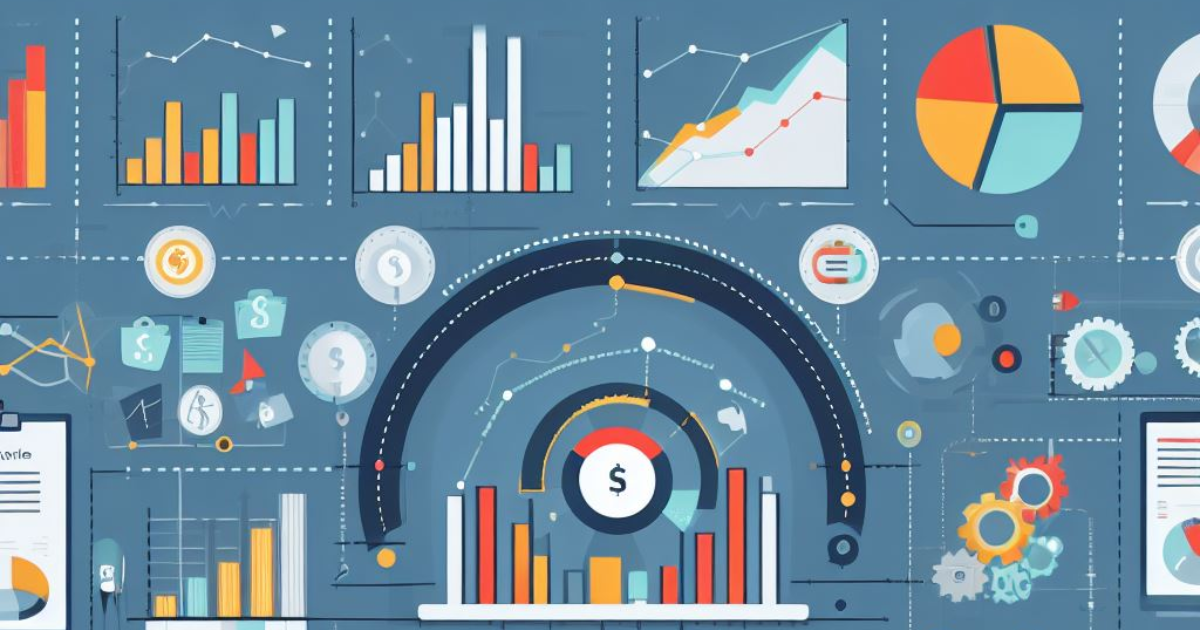Sharing is caring!

In today’s competitive business landscape, having a well-designed revenue cycle KPI dashboard is essential for achieving success. This powerful tool provides valuable insights into the financial health of your organization and helps you make informed decisions to drive growth. By tracking key performance indicators (KPIs) related to revenue generation and cash flow, a well-designed dashboard empowers you to identify areas of improvement, optimize processes, and ultimately maximize profitability. In this article, we will explore the importance of a well-designed revenue cycle KPI dashboard and how it can revolutionize your business operations.
A revenue cycle KPI dashboard is a visual representation of key performance indicators related to a company’s revenue cycle processes. It provides a comprehensive overview of the financial health of the business and helps in tracking and analyzing important metrics. This dashboard is crucial for businesses as it allows them to monitor and measure their revenue generation and collection processes effectively. By having a clear and concise view of the performance of various revenue cycle activities, businesses can make informed decisions, identify areas for improvement, and take necessary actions to optimize their revenue cycle operations.
A well-designed revenue cycle KPI dashboard contributes significantly to the success of a company by providing actionable insights and facilitating data-driven decision-making. It helps in identifying bottlenecks and inefficiencies in the revenue cycle processes, enabling businesses to streamline their operations and improve overall efficiency. By monitoring key metrics and indicators in real-time, businesses can proactively address issues and make necessary adjustments to ensure smooth cash flow and financial stability. This, in turn, leads to improved customer satisfaction, increased revenue, and enhanced profitability.
Key metrics and indicators typically included in a revenue cycle KPI dashboard may vary depending on the specific needs and goals of the business. However, some common metrics include accounts receivable (AR) aging, days sales outstanding (DSO), collection rates, denial rates, net revenue, gross margin, and cash flow. These metrics provide insights into the effectiveness of billing and collections processes, revenue generation, and overall financial performance. By tracking these metrics regularly, businesses can identify trends, spot areas of concern, and take proactive measures to optimize their revenue cycle operations.
A revenue cycle KPI dashboard helps in identifying bottlenecks and areas for improvement by providing a visual representation of key metrics and indicators. By analyzing the data presented in the dashboard, businesses can identify patterns, trends, and anomalies that may indicate potential bottlenecks or areas of concern. For example, a high denial rate or a prolonged AR aging may indicate issues with the billing or collections processes. By pinpointing these bottlenecks, businesses can take necessary actions to address the root causes and improve efficiency. Additionally, the dashboard allows for drill-down capabilities, enabling businesses to dig deeper into specific metrics and identify the underlying factors contributing to bottlenecks.
Yes, a revenue cycle KPI dashboard can help in streamlining billing and collections processes, especially in the context of Medical Billing KPI. By monitoring metrics such as denial rates, collection rates, and AR aging, businesses can identify areas of improvement in their billing and collections workflows. For example, if a high denial rate is observed, it may indicate issues with coding or documentation. By addressing these issues, businesses can reduce denials, accelerate collections, and improve overall cash flow. The dashboard also provides visibility into the status of outstanding invoices, allowing businesses to prioritize collections efforts and ensure timely payments.
Data visualization plays a crucial role in a well-designed revenue cycle KPI dashboard. It allows businesses to present complex data in a visually appealing and easily understandable format. By using charts, graphs, and other visual elements, businesses can quickly grasp the performance of various revenue cycle processes and identify trends or patterns. Data visualization also enables businesses to compare different metrics and indicators side by side, facilitating better analysis and decision-making. Additionally, visual representations make it easier to communicate insights and findings to stakeholders, promoting a better understanding of the revenue cycle performance.
A revenue cycle KPI dashboard helps in monitoring cash flow and financial performance by providing real-time insights into key metrics such as net revenue, DSO, and cash collections. By tracking these metrics, businesses can identify any fluctuations or deviations from the expected performance and take necessary actions to ensure healthy cash flow. The dashboard also allows businesses to monitor the efficiency of their revenue generation and collections processes, enabling them to optimize their operations and improve financial performance. By having a clear view of cash flow and financial performance, businesses can make informed decisions and plan for future growth and investments.
While a revenue cycle KPI dashboard can benefit businesses across various industries and sectors, it is particularly valuable for industries that heavily rely on billing and collections processes, such as healthcare, finance, and telecommunications. These industries often deal with complex revenue cycles involving multiple stakeholders, intricate billing systems, and regulatory compliance. A revenue cycle KPI dashboard provides transparency and visibility into these processes, allowing businesses to identify areas for improvement and optimize their revenue generation and collections efforts.
Implementing a revenue cycle KPI dashboard can come with its own set of challenges. One common challenge is ensuring data accuracy and reliability. It is crucial to have robust data collection and validation processes in place to ensure the integrity of the metrics displayed on the dashboard. Additionally, integrating data from multiple systems and sources can be complex and time-consuming. It requires careful planning and coordination to ensure a seamless flow of data into the dashboard. Another challenge is selecting the right metrics and indicators that align with the business goals and objectives. It is important to identify the most relevant metrics that provide actionable insights and align with the overall revenue cycle strategy.
A revenue cycle KPI dashboard can assist in identifying revenue leakage and minimizing losses by tracking metrics such as denial rates, bad debt ratios, and uncollectible accounts. These metrics help businesses identify areas where revenue is being lost or not fully realized. For example, a high denial rate may indicate issues with claims submission or coding errors, leading to lost revenue. By addressing these issues, businesses can minimize revenue leakage and maximize collections. The dashboard also provides visibility into accounts that are at risk of becoming bad debt, allowing businesses to take proactive measures to mitigate losses.
When designing a revenue cycle KPI dashboard, it is essential to consider some best practices. Firstly, it is important to involve key stakeholders from different departments to ensure that the dashboard meets the needs of the business. Secondly, the dashboard should be user-friendly and intuitive, with clear visualizations and easy navigation. It should present the most relevant metrics in a concise and easily understandable format. Additionally, the dashboard should be regularly updated with real-time data to provide accurate insights. Lastly, it is important to continuously evaluate and refine the dashboard based on feedback and changing business needs to ensure its effectiveness in driving performance improvement.
Yes, a revenue cycle KPI dashboard can help in identifying trends and forecasting future revenue. By analyzing historical data and tracking key metrics over time, businesses can identify patterns and trends that can be used to forecast future revenue. For example, by analyzing DSO trends, businesses can project future cash flow and collections performance. Additionally, the dashboard can provide insights into the impact of changes in revenue cycle processes or external factors on revenue generation. This helps businesses make informed decisions and develop strategies to optimize revenue generation and meet financial goals.
A revenue cycle KPI dashboard can lead to potential cost-saving benefits by optimizing revenue cycle processes and reducing inefficiencies. By identifying bottlenecks and areas for improvement, businesses can streamline their operations, reduce manual errors, and eliminate redundant tasks. This leads to increased efficiency, reduced labor costs, and improved productivity. Additionally, by monitoring metrics such as denial rates and AR aging, businesses can proactively address issues and reduce revenue leakage. This helps in maximizing collections and minimizing losses, resulting in improved cash flow and financial performance.
A revenue cycle KPI dashboard helps in aligning financial goals with operational strategies by providing visibility into the performance of revenue cycle processes. By tracking key metrics and indicators, businesses can ensure that their operational strategies are aligned with financial goals. For example, if the goal is to reduce DSO, the dashboard can provide insights into the effectiveness of collections efforts and help in identifying areas for improvement. This allows businesses to align their operational strategies, such as implementing automated collections processes or improving billing accuracy, to achieve the desired financial outcomes.
There are several software and tools available in the market specifically designed for revenue cycle KPI dashboards. These tools offer features such as data integration, visualization, and analytics capabilities, making it easier for businesses to design and implement effective dashboards. Some popular software options include Tableau, Power BI, QlikView, and Domo. These tools allow businesses to connect and integrate data from various sources, create visually appealing dashboards, and perform in-depth analysis to gain valuable insights into their revenue cycle performance.
In conclusion, a well-designed revenue cycle KPI dashboard is crucial for the success of your business. It provides a comprehensive overview of your financial health and allows you to track and analyze important metrics. By monitoring key performance indicators related to your revenue cycle processes, you can make informed decisions, identify areas for improvement, and optimize your operations. This leads to improved cash flow, increased revenue, and enhanced profitability. With a clear and concise view of your performance, you can proactively address issues and take necessary actions to ensure financial stability. A revenue cycle KPI dashboard is an invaluable tool for driving performance improvement and achieving your business goals.




